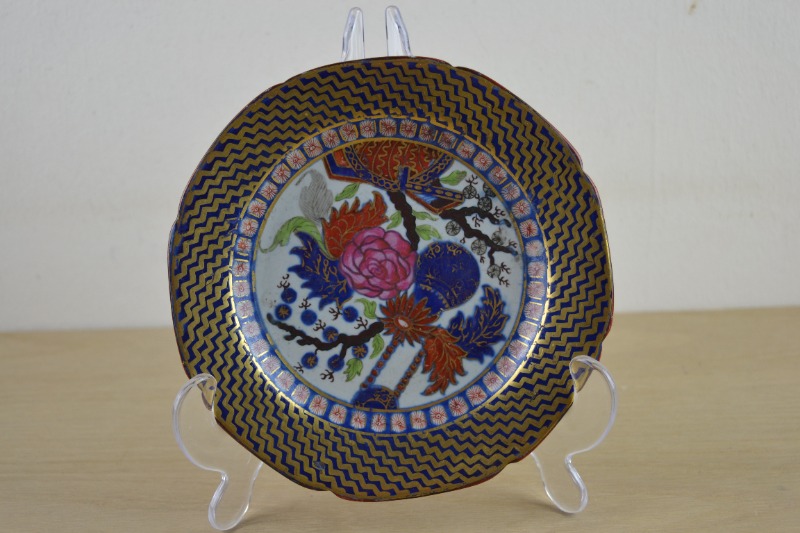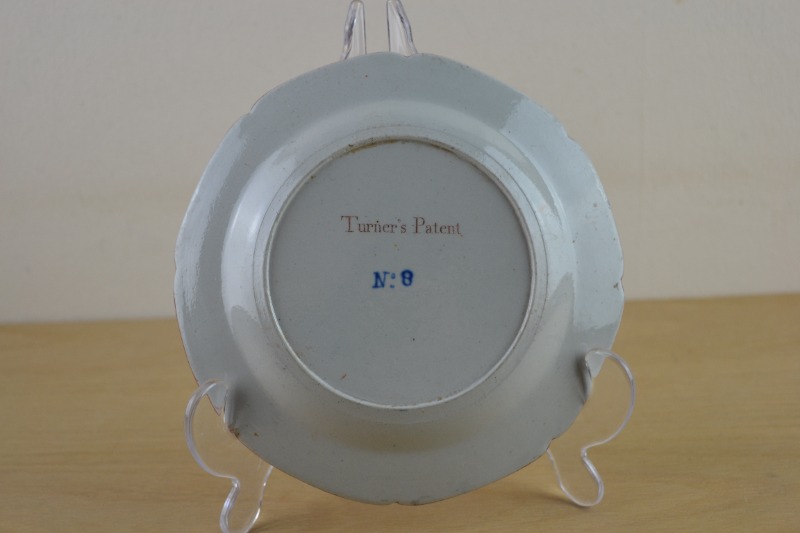Rare ‘Turner Patent’ Hand-painted Ironstone Dessert Plate with Chinoiserie pattern No. 8, 1800-1805
Age:
1800-1805
Material:
Porcelain
Dimensions:
Diameter: 15.5cm
Shipping:
Standard Parcel
Price:
£ 70
This item is available to view and buy at:
Carse of Cambus
Doune
Stirlingshire
FK16 6HG
Finely potted and painted dessert plate with Chinoiserie vase and flowers and red and blue leaves against fruiting branches, surrounded by a diaper pattern and on the scalloped rim, radiating zigzags in gold against deep blue cobalt, with a brown-red edge. Turner’s Patent is printed in red on the underside and in blue the pattern number, No. 8.
The Turner family business commenced in 1760, just as British pottery was entering its heyday as part of the Industrial Revolution. The original John Turner, the son of a lawyer, was an energetic master potter, experimenter and clay hunter who had developed a range of stoneware and earthenware and had been accorded the title “Potter to the Prince of Wales”.
Following John’s death in 1787, his sons John and William took over. After discovering a new source of clay, the Turners developed the first vitrified stone ware in 1800 which they patented as “Patent Stone”. This fine creamy-white ironstone-like earthenware was of very fine quality and “was used for dessert services and other useful wares, always neatly potted and often decorated with colourful ‘Japan’ patterns. The body bears the painted mark ‘Turner’s Patent’; examples are rare.” (Geoffrey Godden). It is recorded that Josiah Spode purchased the patent rights about 1805 and renamed the body “Stone China”. In 1806, impacted by the French Revolution and disruptions to trade, the Turner brothers became bankrupt.
"In 1800, Mr. W. Turner having amused himself with examining by chemical analysis the different strata perforated in sinking a new shaft of a Coal Pit at Milfield Gate, discovered, in what is called the Taberner‘s (or Little) Mine, a mineral, which by calcination becomes a pearl white, yet unlike other minerals, does not shrink by the most ardent temperature to which it has been subjected — 130° of Wedgwood‘s pyrometer. This is now called Patent Stone, in consequence of the brothers Turner having obtained Letters Patent for manufacturing, with it as one material, a real Porcelain, wholly different from any previously manufactured. The stone is very different from the Iron Stone; and therefore the present Patent Ironstone China must not be confounded with the other Patent Porcelains, Champion‘s and Turners‘. (‘History of the Staffordshire Potteries‘, published in 1829 by Simeon Shaw)


